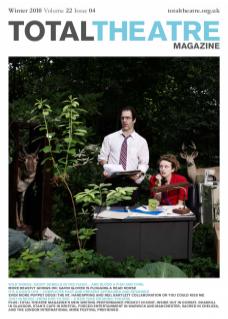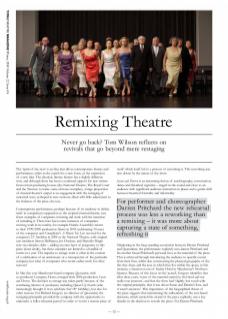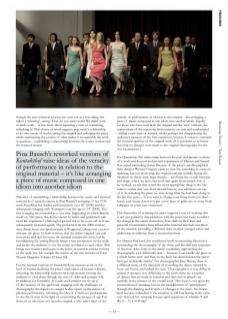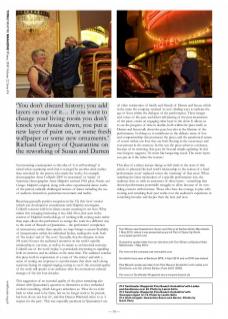The ‘spirit of the new’ is an idea that drives contemporary theatre and performance, either in the search for a new form, or the expression of a new idea. The classical, literary theatre has a slightly different view, and although there has been a continual support for new writers from certain producing houses (the National Theatre, The Royal Court and the Traverse to name some obvious examples), a large proportion of classical theatre’s output is an engagement with the restaging of canonical texts, reshaped in new versions, albeit with little adjustment to the skeleton of the piece, the text.
Contemporary performance, perhaps because of its tendency to define itself in comparison/opposition to the scripted classical theatre, sees fewer examples of companies revisiting old work with the intention of remaking it. There have been some instances of companies reviving work in its totality, for example Frantic Assembly’s return to their 1999/2000 production Hymns in 2005 (celebrating 10 years of the company) and Complicite’s A Minute Too Late (revived for the company’s 21st birthday in 2005 at the National Theatre, with original cast members Simon McBurney, Jos Houben, and Marcello Magni now two decades older – adding an extra layer of poignancy to this piece about death), but these examples are limited to a handful of events in a year. The impulse to restage work is often in the context of a celebration of an anniversary or a retrospective of the particular company, but what of companies who revisit earlier work for other reasons?
In May this year Manchester-based company Quarantine, with co-producers Company Fierce, restaged their 2006 production Susan and Darren. The decision to restage was taken partly because of the continuing interest of producers, including Queer Up North (who interestingly brought it in to celebrate their 18th birthday), but also for other reasons. For Richard Gregory (co-director of Quarantine) the restaging principally provided the company with the opportunity to undertake ‘a fuller rehearsal period’ in order to ‘revisit a mature piece of work’ which itself led to a process of reworking it. This reworking was also driven by the nature of the show.
Susan and Darren is an interesting fusion of autobiography, conversation, dance and theatrical vignettes – staged in-the-round and close to an audience with significant audience interaction in places and a gentle shift between theatrical formality and informality.
Originating in the long-standing association between Darren Pritchard and Quarantine, the performance explicitly uses dancer Pritchard and his mother Susan Pritchard’s personal lives as the material of the piece. This is achieved through introducing the audience to specific events from their lives, whilst also constructing the physical geography of the flat they share and the area in which they live within the space; in this instance, a function room of Sachas Hotel in Manchester’s Northern Quarter. Because of this focus on the ‘actual’, Gregory identifies that after three years, ‘some of the material started to feel tired and not really true anymore’, and that the show had ‘slightly lost touch with the original principles, that it was about Susan and Darren’s lives, and it wasn’t anymore’. This importance of the biographical thrust of the piece suggests that maintaining the authenticity of the text-based elements, which carried this strand of the piece explicitly, was a key decider in the decision to rework the piece. For Darren Pritchard, though, the new rehearsal process was seen not as a reworking, but rather a ‘remixing’, asking: ‘How do you undo work? We didn’t want to undo work… it was more about capturing a state of something, refreshing it.’ This choice of word suggests pop music’s relationship to its own canon of works, taking the original and reshaping the piece whilst maintaining the essence of what makes it recognisably the work in question – establishing a relationship between the source version and the remixed version.
This idea of maintaining a relationship between the source and remixed versions is of central concern in Pina Bausch’s restaging of her 1978 work Kontakthof, for ‘Ladies and Gentlemen over 65’ (2000) and the subsequent restaging with ‘Teenagers over the age of 14’ (2008). The first restaging was intended as a ‘one-time happening’ in which Bausch could see ‘this piece, this theme shown by ladies and gentlemen with more life experience’. (Although it proved not to be a one-off as it was subsequently recreated again!) The performers (in the 2000 version) were drawn from non-professionals in Wuppertal, taking over a year to rehearse the piece. In both versions, that for elders (original cast and recreation) and that for teens, the material remains the same, but by reconfiguring the casting Bausch brings a new perspective on the work and invites the audience to see the works in relation to each other. This brings new nuances and layers to the piece, as noted in various reviews of the work (see for example the review of the two versions in Total Theatre Magazine Volume 22 Issue 02).
For the remixed versions of Kontakthof these nuances work on the level of recontextualising the piece’s exploration of human relations, relocating the relationship between men and women, inviting the audience to view them through the eyes of older and younger folk. In addition, for Kontakthof for Ladies and Gentlemen over the age of 65, the nuances of the aged body engaging with the challenges of choreography developed on younger bodies opens up the nature of physical performance, reframing the idea of a ‘virtuoso’ performance to one that is seen in the light of overcoming the ravages of age. For those of us who have not seen the original, it also raises ideas of the veracity of performance in relation to the original – like arranging a piece of music composed in one idiom into another idiom. Equally for those who have seen both the original and the ‘new’ versions, the expectations of the repertoire from memory are met and confounded – adding a new layer of interest, whilst perhaps not disappointing the audience’s memory of the first experience, because it strives to maintain the essential qualities of the original work. (It is pertinent to re-iterate here that no changes were made to the original choreography for the new incarnations.)
For Quarantine this relationship between the past and present versions of a work and the past and present experiences of Darren and Susan’s lives raised interesting points. Because of the piece’s autobiographical basis director Richard Gregory came to view the reworking as a way of updating, but not destroying, the original material, initially having the intention ‘to throw away huge chunks… we’d keep the overall structure and shape, which we have, but we’d start again from scratch, but as we worked, we felt that wasn’t the most appropriate thing to do.’ He came to realise that ‘you don’t discard history; you add layers on top of it. In remaking the piece we were doing what they had been doing in the last five years… if you want to change your living room you don’t knock your house down, you put a new layer of paint on, or some fresh wallpaper or some new ornaments.’
This discussion of remixing the piece suggests a way of working that is not just guided by dissatisfaction with the piece, but looks to reflect the change in the artists themselves, how shifts in their lives and personal circumstances have affected the material and their reception of the material, providing a different slant on their younger selves and addressing an audience from a renewed position.
For Darren Pritchard, this manifested itself in interesting discoveries surrounding the choreography of the show, and the different responses of his, now older, body to the dance vocabulary, approaching the choreography a lot differently now ‘…because I can handle the piece as a whole better now,’ and that, ‘as my body has slowed down the pieces have got technically harder’. For choreographer Jane Mason, there is a different sense of the demands of reworking the dance material in Susan and Darren, and indeed she says: ‘Choreography is a very different animal, it operates very differently in the work; there are a number of dances that are made in isolation and then they’re placed very carefully in the context of the overall work.’ Her focus is not upon the construction of meaning, but on the establishment of ‘atmospheres’ through the dancing, and in spite of changes to the piece, the dances ‘don’t become redundant if the structure is still functioning in the same way’. Instead, her remixing focuses upon questions of whether ‘I still like it… Is it working?’
An interesting counterpoint to this idea of ‘is it still working?’ is raised when examining work that is restaged by another artist (rather than reworked by the person who made the work), for example choreographer Anne Collard’s 2009 ‘re-enactment’ or ‘replay’ of American choreographer Anna Halprin’s seminal 1965 piece Parades and Changes. Halprin’s original, along with other experimental dance works of the period, radically challenged notions of dance including the use of audience interaction, pedestrian movement and nudity.
Receiving generally positive reception in the US, this ‘new’ version (which was developed in consultation with Halprin) investigates Collard’s concern with how dance creates meaning in our lives. What makes this restaging interesting is two-fold. First, that seen in the context of Halprin’s methodology of working with scoring tasks rather than steps allows the performers to restage the work in a different way to the work of Bausch or Quarantine – the performers’ completion of instructions, rather than specific set steps brings a certain flexibility of interpretation within the individual bodies, making the work both of ‘the sixties’ and of ‘the now’. Secondly, that the distance in time (44 years) focuses the audience’s attention on the work’s specific relationship to our time, as well as its nature as an historical curiosity. Collard’s use of the word ‘replay’ is particularly interesting in signalling both its newness and its oldness at the same time. The audience watches this piece both in expectation of a taste of ‘the sixties’ and with a sense of testing our response to a performance that drew such strong reactions during its original staging, testing to see if the essential quality of the work still speaks to an audience after the momentous cultural changes of the last four decades.
This suggestion of an essential quality of the piece remaining also chimes with Quarantine’s question to themselves as they embarked on their reworking, which Gregory articulates as: ‘How do we refer back to what used to be there, but we no longer want to be present, but how do we not lose it?’, and that Darren Pritchard refers to as ‘a respect for the past’. This was especially pertinent in Quarantine’s use of video testimonies of family and friends of Darren and Susan, which in the main the company retained ‘as was’; finding ways to indicate the age of these within the dialogue of the performance. These images and voices of the past, and direct referencing of the past incarnation of the piece, create an engaging other layer to the show. It allows us to see the progress of time in double, both within the piece itself, as Darren and Susan talk about the past, but also in the lifetime of the performance. In doing so, it contributes to the delicate sense of loss and companionship that permeates the piece; and the paradoxical nature of events within our lives that are both fleeting in the occurrence and ever-present in the memory. In this way the piece achieves a richness, because of its remixing, that goes far beyond simple updating. In this way Gregory suggests, ‘it’s more like lacquering wood. The more layers you put on it the richer the texture.’
This idea of a richer texture brings us full circle to the start of this article: to physical/devised work’s relationship to the notion of a fixed ‘performance score’ replayed versus the ‘remixing’ of that score. When watching the latest incarnation of a specific performance text, the audience does so with an awareness of these layers – something that devised performance potentially struggles to allow because of its overriding concern with newness. Those who have the courage to play with revising and remaking their past works root the audience’s experience in something broader and deeper than the here and now.
Tom Wilson saw Quarantine’s Susan and Darren at Sachas Hotel, Manchester, 1 May 2010, where it was presented as part of Part of Queer Up North. www.queerupnorth.com
Quarantine quotes taken from an interview with Tom Wilson at Sachas Hotel, Manchester, 1 May 2010.
For more on the company see www.qtine.com
Kontakthof was seen at Barbican BITE, 4 April 2010 and on DVD (see below).
Pina Bausch quotes are taken from Pina Bausch Kontakthof with Ladies and Gentlemen over 65, L’Arche Editeur, Paris 2007 (DVD).
For more on Tanztheater Wuppertal see www.pina-bausch.de



